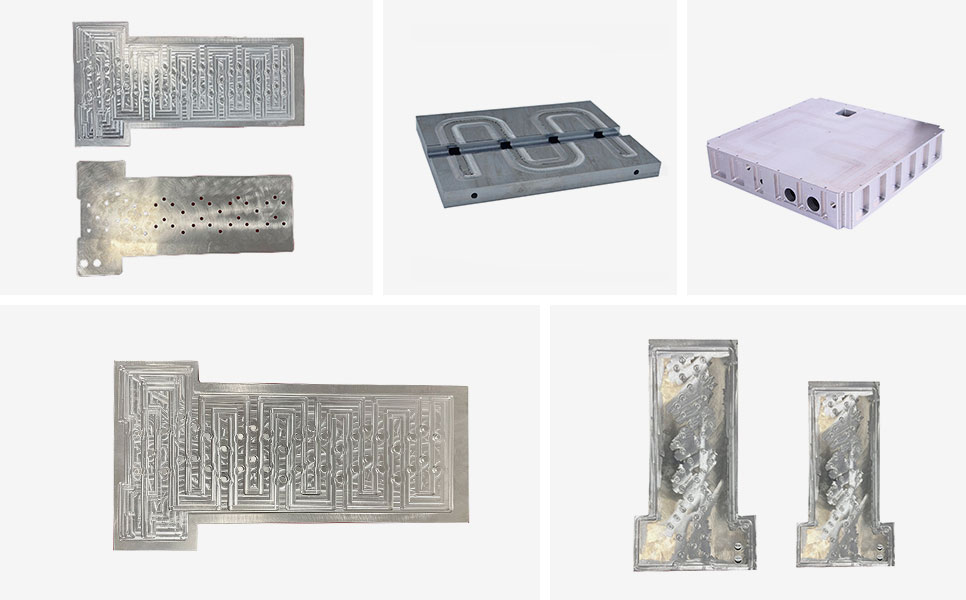Water/liquid cooling plates use a pump to circulate the coolant in the heat pipe and dissipate heat. The heat absorption part on the radiator (called the heat absorption box in the liquid cooling system) is used to dissipate heat from the computer CPU, North Bridge, graphics card, lithium battery, 5G communication equipment, UPS and energy storage system, and large photovoltaic inverter, SVG/SVC absorbs heat on heat dissipation. The heat absorbed by the heat absorption part of our water/liquid cold plates is discharged to the outside through the radiator designed on the back of the pyrogen.
As the leading liquid cooling plate manufacturer in China, Cheeven is committed to producing quality plates and varous FSW products at affordable price. Feel free to contact us for the liquid cooling plate price. These leading water cooling plates have never disappointed the companies we work with.

Material | Aluminum alloy(6063 T5, 6061, 5052, 7075, 1060...), Stainless steel(316L, 304, 303...), Copper, Brass, Bronze, Carbon steel, PET, POM, Teflon, Nylon... |
Machined Technology | 3,4,5 Axis CNC Machining, CNC Milling, CNC Turning, Laser Cutting, Die Casting, Cold forging, Aluminum Extrusion, Sheet Metal Fabrication, Stamping, Welding, Friction Stir Welding, Assembling |
Surface Treatment | Anodizing, Painting, Powder Coating, electrophoresis, Passivation, Sand Blasting, Plating, Blackening, Polishing... |
Tolerance | ±0.01MM |
Drawing Format | IGS, STEP, PDF, JPG... |
Application | New energy vehicles, semiconductors, medical equipment, aerospace |
A liquid cold plate is a device that is used to cool electronic components by circulating a liquid coolant through channels in the plate. For water cooling plate supplier, the design of a water cooling plate depends on several factors, including the size and shape of the components being cooled, the amount of heat that needs to be dissipated, and the type of liquid coolant being used.
Here are some general considerations for designing a liquid cold plate:
Channel design: The channels in the water cooled cold plate should be designed to maximize the contact area between the liquid coolant and the components being cooled. This can be achieved by using a serpentine or zig-zag pattern for the channels, which increases the length of the coolant flow path.
Material selection: The material used for the water cold plate should have good thermal conductivity to efficiently transfer heat from the components to the coolant. Common materials used for liquid cooling plate include copper, aluminum, and stainless steel.
Coolant flow rate: The flow rate of the coolant through the water cooled cold plate should be optimized to achieve the desired cooling performance while minimizing pressure drop in the system. Increasing the flow rate can improve cooling performance, but may also increase system complexity and cost.
Integration with other cooling components: The water cooled cold plate should be designed to integrate with other cooling components in the system, such as pumps, heat exchangers, and tubing. This requires careful consideration of the placement and orientation of the water cold plate and other components, as well as the type and size of connectors used to join them.
Thermal interface materials: The water cold plate should be designed to accommodate thermal interface materials, such as thermal paste or pads, which help to improve heat transfer between the components and the water cooling plate.
Overall, the design of a liquid cooling plate requires careful consideration of multiple factors to achieve optimal cooling performance while minimizing cost and complexity.
A cold plate cooling system is a type of cooling system that uses a flat plate made of a highly conductive material, such as copper or aluminum, to dissipate heat from electronic components. This cold plate cooling system is often used in applications where traditional air cooling methods are insufficient, such as in high-power electronics or in environments with limited airflow.
The liquid cooling plate is typically attached to the electronic component or device that needs to be cooled, and a coolant is circulated through the plate to absorb and carry away heat like the product electric motor water jacket. The coolant can be water, a water-glycol mixture, or other types of fluids, depending on the specific application requirements.
Cold plate cooling systems offer several advantages over traditional air cooling methods, including higher cooling efficiency, more consistent cooling performance, and quieter operation. They are also often more compact and can be used in tight spaces.
However, cold plate cooling systems also have some disadvantages, including the need for additional plumbing and the potential for leaks if the system is not properly maintained. Additionally, the cost of a cold plate cooling system is typically higher than traditional air cooling methods.
Liquid cooling plates are typically used in electronic and thermal management applications, where efficient heat dissipation is necessary. Some common applications of liquid cooling plates include:
Computer servers: High-performance computer servers generate a significant amount of heat, and liquid cooling plates can be used to remove this heat efficiently.
Electric vehicles: Water jacket electric motor is used to drive cars. The batteries in electric vehicles generate heat, which can reduce their lifespan and performance. Liquid nitrogen cold plate can be used to maintain a consistent temperature and extend the lifespan of the batteries.
LED lighting: High-power LED lighting fixtures generate heat, and liquid cold plates can be used to dissipate this heat, ensuring that the LEDs operate at optimal temperatures.
Medical equipment: Medical equipment generates heat, and liquid cold plates can be used to remove this heat efficiently, ensuring that the equipment operates safely and reliably.
Industrial machinery: Heavy-duty machinery generates a lot of heat, and liquid cold plates can be used to remove this heat efficiently, preventing damage to the machinery and ensuring optimal performance.
Industrial automation and robots: In industrial automation equipment and robots, water cooling plates are used to cool key components such as servo motors, drives and controllers to maintain stable operation of the equipment and improve efficiency and reliability.
Overall, liquid cooling plates can be used in any application where efficient heat dissipation is necessary to maintain the performance, reliability, and safety of electronic and mechanical components.
Application Fields Broaden:
In order to broaden the application fields, the liquid cooling plate factory has adopted a variety of strategies and technological innovations to adapt to the needs of different industries. Such as technological innovation: research into the use of composite materials such as carbon fiber to reduce weight and improve thermal performance, especially suitable for the aerospace and automotive industries. High thermal conductivity materials (such as copper, aluminum, copper nickel indium, or their alloys) and advanced manufacturing techniques (such as vacuum brazing) are used to improve the heat transfer efficiency of the cooling plate.
Friction stir welding is a more cost-effective method in terms of operational expenses such as machine investment and cover supply, when compared to EBW or vacuum brazing. By using the Stirweld FSW head, the investment cost can be significantly reduced, and the cover design does not need to be highly precise, allowing for the use of laser-cut covers, which are less expensive than machined covers required for Electron Beam Welding. Additionally, there is a minimal cost of quality control with FSW due to the absence of common defects in other methods such as sticking or channel collapse in vacuum brazing, porosity in electron beam welding, and coolant leaks in service due to fatigue pressure.
| Product name | OEM/ODM custom friction stir welding FSW water cooling/cold aluminum plate |
| Type | Water cooling/cold plate |
| Material | Aluminum/Al/Al alloy |
| Size | Customized |
| Applicable industry | Semiconductor field、Medical field |
| Marketing type | New Product |
| Core components | Other |
| MOQ(pieces) | 5 |
| Shape | As Customer Requirements |
| Processing Type | FSW+CNC/Friction stir welding, machining |
| Tolerance | ±1% |
| Condition | New |
| Warranty(Year) | 1 |
| After Warranty Service | Online support |
| Place of Origin | Zhejiang, China |
| Certification | ISO9001: 2015 standard |
Material Compatibility: FSW friction stir welding is particularly well-suited for joining dissimilar materials, which is often a requirement in water cold plate manufacturing. It can join metals with different properties, enabling the use of materials that provide the best thermal and structural performance.
Reduced Distortion: FSW generates less heat compared to traditional welding techniques, leading to reduced distortion and deformation of the liquid cold plates. This ensures the cooling plate's precise geometry and improves its overall performance.
High Strength Joints: FSW creates strong, defect-free joints with excellent mechanical properties. This is essential for liquid cooling plates, as they must withstand high-pressure and temperature conditions while maintaining structural integrity.
Improved Thermal Conductivity: The low heat input during FSW minimizes the formation of heat-affected zones (HAZ), resulting in improved thermal conductivity compared to traditional welding methods. This is crucial for efficient heat transfer in water cooled cold plates.
As professional liquid cooling plate manufacturer, we have burst pressure test , thermal management, leak test and visual test . The pressure test injecting pressurized water into the liquid cold plate's channel to assess the cover's ability to resist cracking. The water cold plate's thermal resistance and pressure drop were measured and analyzed in an thermal management. The leak test will check the quality of the welded liquid cold plate. And the visual test is for the presence of excessive flash (very common FSW defect), to check if the force applied by the shoulder on the part surface was high enough.
Cheeven, which has a group of skilled professionals specialized in friction stir welding services, offers complete support for your liquid cold plate welding process. You can rely on Cheeven's design department for various aspects, including collaborative design of your water cold plate, development and production of your clamping jig, establishment of your welding parameters and quality assessment, as well as the production of the first sets.
Cheeven, as an experienced FSW water cooling plate company, possesses exceptional manufacturing capabilities. We welcome your inquiries and orders.
Depending on your specific needs, you might want a supplier that can offer customized solutions tailored to your application. This could include different sizes, materials, or configurations. With our own water cooling plate factory, Cheeven can perfectly meet your demands.
Compare prices among different liquid cooling plate manufacturers to ensure that you're getting a competitive deal. However, Cheeven never compromise quality for cost savings, as the performance of the cooling plates is critical.
Buy liquid cooling plate and find out about the warranty provided on water cooling plates and the level of after-sales service we offer in case of any problems.

Cheever offers all types of friction stir welding products to meet your requirements.



As the plates absorb excess electrical heat, they expel it through liquid cooling via the internal channels. These internal channels within the water cold plates can be crafted in a variety of dimensions and forms, enhancing their ability to efficiently absorb and convey substantial heat loads.
The water-cooling plate's primary function is to absorb the heat generated by the heating element and transfer it to the circulating liquid. In contrast, the radiator's role is to take in the heat from the liquid, using fins, and then facilitate heat exchange between the surrounding outside air and the fin surface.
When deciding between using a water cooling plate or cold plate for thermal management, it's important to understand their distinctions. Both of these solutions provide a means of conductive cooling, involving direct contact between components at varying temperatures. The key distinction between heat sinks and liquid cooling plates lies in the presence or absence of fins.
FSW (Friction Stir Welding) cold plate manufacturing involves selecting suitable materials, preparing the base plate, setting up specialized tooling, and applying FSW. During FSW welding a rotating pin generates friction, softening the materials without melting them. The softened materials are stirred and forged together, forming a strong joint. Cooling is essential to control temperature.